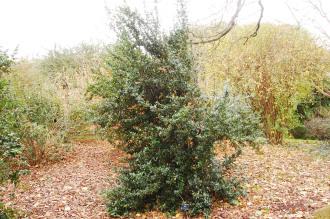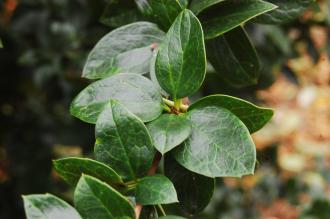
Berberis valdiviana (07/12/2015, Kew Gardens, London)
Position: Full Sun to partial shade
Flowering period: Late spring
Soil: Moist, well drained
Eventual Height: 4m
Eventual Spread: 4m
Hardiness: 7b, 8a, 8b, 9a, 9b
Family: Berberidaceae
Berberis valdiviana is an evergreen shrub with a bushy habit. Its dark green glossy leaves are elliptic to ovate with entire to mildly spiny margins, up to 7.5m long and 4cm across. Its fragrant yellow/ orange flowers are up to 8mm across and are produced on hanging racemes which are up to 7cm long. Its purple fruit is a globose berry and up to 8mm across.
Berberis valdiviana, commonly known as Barberry, is native to Chile.
The etymological root of the binomial name for Berberis is derived from the Arabic برباريس, the Arabic name for Berberis. Valdiviana is derived from the Latin meaning ‘ from Valdivia Province, Chile’.

Berberis valdiviana Leaf (07/12/2015, Kew Gardens, London)
When available the landscape architect may find Berberis valdiviana useful as an attractive evergreen spring flowering shrub.
Ecologically, Berberis valdiviana flowers are attractive to pollinating insects. The fruit also attractive to birds and some mammals.
The Royal Horticultural Society have given Berberis valdiviana their prestigious Award of Garden Merit in 2012.
Berberis valdiviana prefers moist, fertile, well-drained soils. It tolerates most pH of soil.
Berberis valdiviana requires little maintenance. Necessary pruning should be carried out after flowering.

Landscape Architecture

